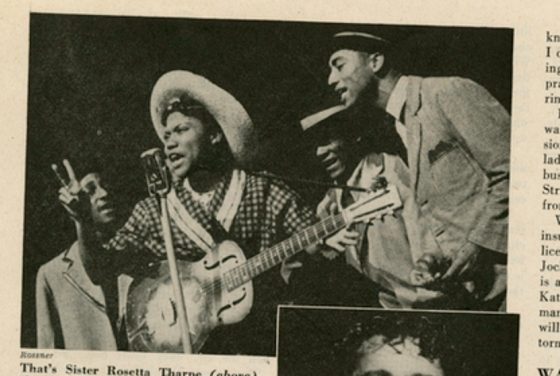What if I told you that the Grandmother of Rock’n’Roll was an LGBTQ+ black female guitarist? A woman whose “grandchildren” include Chuck Berry, Elvis Presley, Led Zeppelin, the Rolling Stones, Fleetwood Mac, and Eric Clapton.
Sister Rosetta Tharpe, a queer black female gospel electro guitarist, who managed to rise to fame, die forgotten, and reappear again on the musical horizon in the early 20th century only to be named one of the inventors of Rock’n’Roll.
Born in Cotton Town, Arkansas, in 1915, into an evangelical family, Sister Rosetta Tharpe, nee Rosetta Nubin, was an early music prodigy, picking up the guitar, which at the time was not nearly as popular or glossy of an instrument as it is now, at the age of six. Performing with a religious musical troupe with her mother all over the South of America, she quickly developed her talent in the gospel with a punch of home-modified electric guitar.
When at the age of 23, in 1938, Cab Calloway noticed Tharpe performing on the streets of New York, he didn’t so much as hesitate to invite the young guitarist to perform at the Cotton Club, a famous then venue that catered predominantly to the middle-class white mass audiences interested in the rising African American scene. Loud, smiling, unapologetic about her love for music and life, Tharpe was an instant success.
In fact, her fame grew so rapidly that Tharpe signed with Decca Records in October 1938, four months later, therefore becoming the first-ever gospel performer to be featured at the label’s records. The record company struggled to put the newly discovered singer and guitarist into a box, and decided to promote her music as “spirituals in swing”, somehow allowing Sister Rosetta Tharpe to bridge her predominantly religious lyrics with the audience’s dance music demands. Seeing a woman, who could “swing the same songs in church and night club” was highly unusual and intoxicating.
Her bright persona attracted so much attention, that in 1941, Life magazine, which was known for its rare attention towards African American celebrities, devoted a photo essay to Sister Rosetta Tharpe, where she was depicted in a church concert on Sunday and a nightclub performance the following Monday night, with her signature bright smile on and white Gibson in hand.
Historically African American musicians had the lion’s share of influence on Rock’n’Roll. However, in the collective imagination of the listeners, the token early rocker is still a loud, aggressive guitar player, who happens to be white, young, and male (preferably whistling an opening cue to Jailhouse Rock). But if we take a closer look at Tharpe’s music, we are bound to find the same sense of boiling energy, electrifying guitar riffs and infectious rhythm. One of her signature hits, ‘Strange Things Happening Everyday’, a rendition of a gospel song, is declared to be the first rock song to ever be recorded. Sister Rosetta Tharpe’s distorted guitar sound, lyrical play, and rather flamboyant stage looks all made her the real rock star of her time.
Sister Rosetta Tharpe did not cut it within popular music. She was neither a black man to be considered an “authentic blues guitarist”, nor a conventional black woman big band soloist pre-cut for wider white audience appeal. A powerful figure with enigmatic presence, an openly queer woman, who scandalously performed with her lover, Marie Knight, she didn’t stand a chance in the conservative music world of the 1950s.
Gradually, as gospel and blues music popularity began to fade during the 1950s and ’60s, so did the audience’s interest in unpacking Sister Rosetta Tharpe’s curious stage presence. In 1964 she still toured with Muddy Waters as a part of Gospel Train across Europe, later into the decade the popular music industry seemed to have forgotten about Tharpe altogether. After years of relative poverty, health struggles, and oblivion, Sister Rosetta Tharpe died at the age of 58 with her partner, Marie Knight, by her side. Rock’n’Roll Grandma was buried modestly in 1973, her grave remaining unmarked for the next 45 years.
It wasn’t until 2018 when Sister Rosetta Tharpe was inducted into the Rock’n’Roll Hall of Fame, that the interest in her persona began to rise again among the wider audiences. Suddenly, there was an article in the Rolling Stone trying to explain why exactly this “woman from the 1930’s” deserved to be among such “titans” of rock like Presley and Clapton. A steady flow of “omg how did I not know about her earlier?” under Tharpe’s YouTube videos. It seemed as if finally, the world was ready to accept the fact that maybe, just maybe, the face of Rock’n’Roll has never been white or male or heterosexual. Right about time for us to recognize that the beaten track walked so comfortably by Presley’s blue suede shoes was originally laid by a black queer grandma in the shining white mink coat.
Have something to say about one of our articles? Send in a Letter to the Editors by filling out the Google Form below!: https://forms.gle/ExkphSLQ6C9F2zcf9

